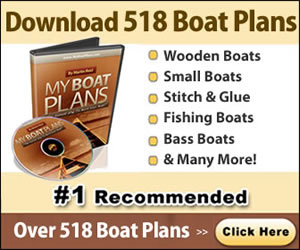 Graham has written with a comment about leeboards: -
Graham has written with a comment about leeboards: -Nice pics. My life seems to be one long series of overdue jobs, so I know what a relief it is to be back on task!
The external chine logs I dont mind so much, but the leeboard?? I know there are some really good practical reasons for going down that path, and I know that Phil Bolger was a great advocate of them, but they take some getting used to.
Apart from the increased internal space, do you think you could just remind me what the benefits of a leeboard are; especially when used in conjunction with a flat bottomed hull like this one.
Well, Im not an expert on the subjuect, but the most obvious advantage of leeboards is exactly what Graham has pointed out - less clutter inside the part of the boat in which people want to sit. Now, having a centreboard case in there with you is not necessarily a bad thing. Ive found a case to be a great way to brace ones feet; to bundle people away from each other when sleeping; and to use as a sort of improvised set of hiking straps by hooking the soles of your feet under the upper external framing of the case while hiking out.
Another advantage of leeboards is that they are providing lateral plane from the surface of the water down to their tips, rather than from the bottom of the centreboard case to the tip. The problem there is that I suspect that the "end plate" effect of the bottom of the hull over the centreboard more than makes up for the increased effective area of the leeboard.
But despite all of that (including arguements about better hull strength without a centreboard slot), there is one overwhelming practical advantage of leeboards for a cruising dinghy, and that is avoiding the plague of having sand and shell-grit pumped up into the centreboard slot while the boat is pulled onto the beach with wavelets surrounding her. That is the reason why my centreboard designs have a positive method of forcing the centreboard down, rather than just relying on a block of ballasting lead in the board - a jambed board is a potentially serious problem, particularly when leaving a lee shore - you must be able to get the board down quickly, and the combination of sand and shel-grit inside a case is a serious problem. It is also a very good arguement in favour of a dagger board rather than a pivoting centreboard.
Ive been having an interesting discussion with a fellow in Maine about the effectivness of long, shallow keels. He sails a Phil Bolger Oldshoe and I occasionally sail a Bolger Micro - both of which have long, shallow keels. Both of us have been pleasantly surprised by just how effective these keels are - despite what the theorists will tell you. If you get the chance, read Arthur Ramsomes books in the Swallows and Amazons series (I read my first one at about eight years of age, and Im still reading the twelve-book series on a regular basis - they are that good), where he describes Swallow, a 14 ft clinker sailing dinghy with a shallow keel.
| Here is me sailing along happily in my leeboard-equipped Bolger Nymph. The boat is on a run, with the boards raised, but I can assure you that they worked very well indeed! |
| This jpg shows my Whimbrel design (17ft x 6ft 9in), which incorporates leeboards for many of the above reasons. These plans are quite detailed, and although close to being finished, will still be a month or so. Too much work on my plate, and only one person to do the jobs! |







0 komentar:
Posting Komentar